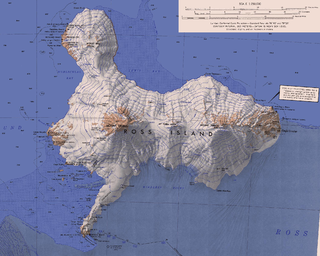
Nikopol Point is a snow-free point on the south coast of Byers Peninsula, Livingston Island in the South Shetland Islands, Antarctica projecting 650 m east-southeastwards into Bransfield Strait and linked by a spit to Vietor Rock to the south. The area was visited by early 19th century sealers who had dwellings at the foothills of nearby Sealer Hill.

Camp Byers is a Spanish seasonal base camp on Byers Peninsula, Livingston Island in the South Shetland Islands, Antarctica. The locality is also designated for use as an International Field Camp. When necessary for scientific research purposes, temporary camping is allowed elsewhere under certain conditions.

Bilyar Point is a rounded ice-free point on Ivanov Beach in western Livingston Island, the South Shetland Islands in Antarctica projecting 350 m into Barclay Bay. Situated 3 km southwest of Rowe Point, northwest of Rotch Dome, 1.7 km northeast of Nedelya Point and 4.5 km east-northeast of Lair Point.

Kardzhali Point is the rocky point forming the south side of the entrance to Ograzhden Cove on the northwest coast of Ray Promontory of Byers Peninsula, Livingston Island in the South Shetland Islands, Antarctica. It is situated 680 m south of Essex Point, 1.23 km east-northeast of Isbul Point and 1.98 km east-northeast of Start Point.

Urvich Wall is the narrow ice-free and crescent-shaped ridge rising to 121 m on Livingston Island in the South Shetland Islands, Antarctica and bounded by Nedelya Point to the north and Rish Point to the southeast. Extending 6.7 km and up to 400 m wide, the ridge separates Byers Peninsula to the west from Rotch Dome to the east.

Drong Hill is the double rocky hill rising to 179 m in the northwest extremity of Dospey Heights on Byers Peninsula, Livingston Island in the South Shetland Islands, Antarctica. Situated 550 m east-southeast of Essex Point, 1.52 km west of Voyteh Point and 600 m northeast of Kardzhali Point.

Aglen Point is a rocky point forming the west side of the entrance to Richards Cove on the north coast of Ray Promontory in the northwestern part of Byers Peninsula on Livingston Island in the South Shetland Islands, Antarctica. Situated 470 m west of Voyteh Point and 1.6 km east of Essex Point. The area was visited by early 19th century sealers.

Tsamblak Hill is a rocky hill trending 900 m in north-south direction, 450 m wide and rising to 113 m in eastern Byers Peninsula on Livingston Island in the South Shetland Islands, Antarctica.

Nedelya Point is a sharp ice-free point at the southwest extremity of Ivanov Beach on the north coast of Livingston Island in the South Shetland Islands, Antarctica projecting 300 m into Barclay Bay. It is linked by a chain of rocks to Cutler Stack located 310 m to the north-northwest. The feature is part of the Antarctic Specially Protected Area ASPA 126 Byers Peninsula, situated in one of its two restricted zones.

Battenberg Hill is a rocky hill rising to 166 m in Dospey Heights on Byers Peninsula of Livingston Island in the South Shetland Islands, Antarctica. Situated 1.8 km east of Start Hill, 1.8 km south of Voyteh Point and 2.19 km northwest of Penca Hill.

Essex Point is a point at the northwest end of Byers Peninsula, Livingston Island in the South Shetland Islands, Antarctica. It forms the west side of the entrance to Barclay Bay and the northeast side of the entrance to Svishtov Cove, and is surmounted by Drong Hill.

Ray Promontory is the 7 km long and 2.8 km wide promontory lying between Barclay Bay and the New Plymouth sound, and forming the northwest part of Byers Peninsula, Livingston Island in the South Shetland Islands, Antarctica ending up in Start Point and Essex Point. The promontory's interior is mostly occupied by Dospey Heights.

Penca Hill is a rocky hill rising to 217 m in Dospey Heights on Byers Peninsula, Livingston Island in the South Shetland Islands, Antarctica.

Lair Point is a point projecting 570 m into Barclay Bay from Robbery Beaches on Byers Peninsula, Livingston Island in the South Shetland Islands, Antarctica and forming the east side of the entrance to Kukuzel Cove. Dominated by Lair Hill.

Ocoa Point is a steep headland backed by raised beach terraces at the head of New Plymouth harbour in Byers Peninsula, Livingston Island in the South Shetland Islands, Antarctica. The area was visited by 19th century sealers.

Rame Bluff is a rocky headland on the southwest side of Ray Promontory formed by an offshoot of Dulo Hill, and marking the northern limit of President Beaches on Byers Peninsula, Livingston Island in the South Shetland Islands, Antarctica. The area was visited by 19th century sealers.

Sàbat Hill is the ice-free hill rising to 151 m in Dospey Heights on the Ray Promontory of Byers Peninsula, Livingston Island in the South Shetland Islands, Antarctica. Surmounting Richards Cove to the west-northwest and Barclay Bay to the east.

Enrique Hill is the ice-free hill rising to 156 m in Dospey Heights on the Ray Promontory of Byers Peninsula, Livingston Island in the South Shetland Islands, Antarctica. Surmounting Barclay Bay to the east and northeast.













